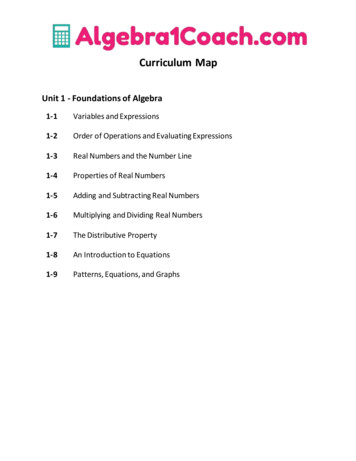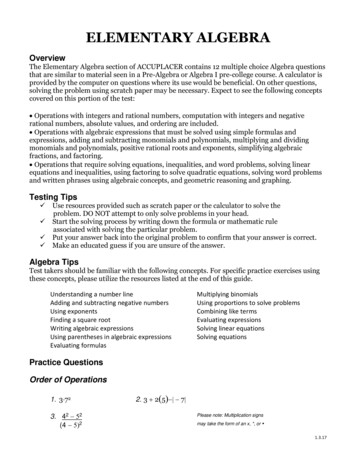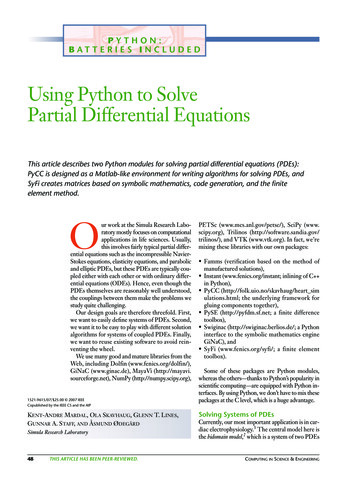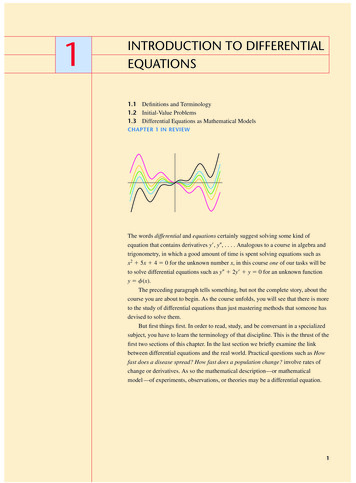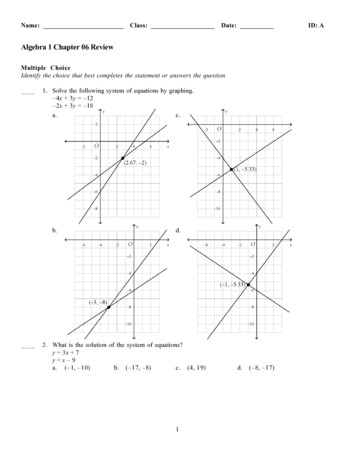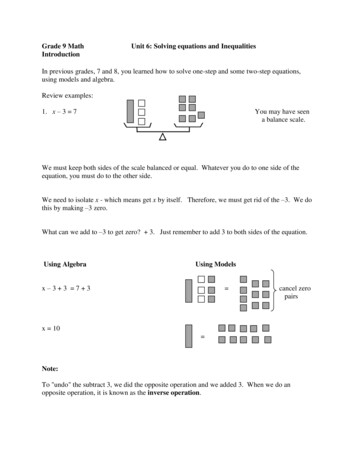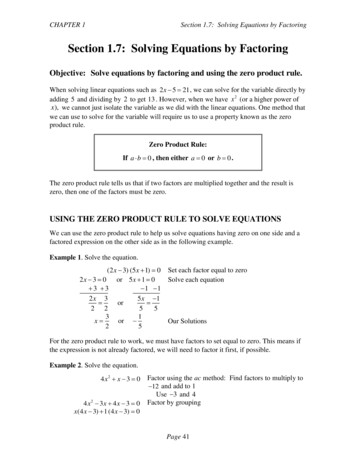
Transcription
CHAPTER 1Section 1.7: Solving Equations by FactoringSection 1.7: Solving Equations by FactoringObjective: Solve equations by factoring and using the zero product rule.When solving linear equations such as 2 x 5 21 , we can solve for the variable directly byadding 5 and dividing by 2 to get 13 . However, when we have x 2 (or a higher power ofx), we cannot just isolate the variable as we did with the linear equations. One method thatwe can use to solve for the variable will require us to use a property known as the zeroproduct rule.Zero Product Rule:If a b 0 , then either a 0 or b 0 .The zero product rule tells us that if two factors are multiplied together and the result iszero, then one of the factors must be zero.USING THE ZERO PRODUCT RULE TO SOLVE EQUATIONSWe can use the zero product rule to help us solve equations having zero on one side and afactored expression on the other side as in the following example.Example 1. Solve the equation.(2 x 3) (5 x 1) 0 Set each factor equal to zeroSolve each equation2 x 3 0 or 5 x 1 0 3 3 1 12x 35 x 1 or 2 25531x or Our Solutions25For the zero product rule to work, we must have factors to set equal to zero. This means ifthe expression is not already factored, we will need to factor it first, if possible.Example 2. Solve the equation.4 x2 x 3 04 x 2 3x 4 x 3 0x(4 x 3) 1 (4 x 3) 0Factor using the ac method: Find factors to multiply to 12 and add to 1Use 3 and 4Factor by groupingPage 41
CHAPTER 1Section 1.7: Solving Equations by Factoring(4 x 3) ( x 1) 0 Set each factor equal to zero4 x 3 0 orx 1 0 Solve each equation 3 3 1 14x 3 orx 14 43x or 1Our Solutions4Another important part of the zero product rule is that before we factor, one side of theequation must be zero. If one side of the equation is not zero, we must move terms aroundso that one side of the equation is zero. Generally, we like the coefficient of the x 2 term tobe positive.Example 3. Solve the equation.x 2 8 x 15 8 x 15 8 x 15x 2 8 x 15 0x 5 0 5 5x 5x 5( x 5) ( x 3) 0orx 3 0 3 3orx 3or x 3Set one side equal to 0, adding 8x and 15 to bothsides of the equationFactor using the ac method: Find factors to multiply to15 and add to 8Use 5 and 3Set each factor equal to zeroSolve each equationOur SolutionsExample 4. Solve the equation.( x 7) ( x 3) 9x 7 x 3x 21 9x 2 4 x 21 9 9 92x 2 4 x 12 0( x 6) ( x 2) 0x 6 0orx 2 0 6 6 2 2x 6orx 2Not equal to zero; multiply first using FOILCombine like termsSet one side equal to 0 by adding 9 to both sides of theequationFactor using the ac method: Find factors to multiply to 12 and add to 4Use 6 and 2Set each factor equal to zeroSolve each equationOur SolutionsPage 42
CHAPTER 1Section 1.7: Solving Equations by FactoringExample 5. Solve the equation.3 x 2 4 x 5 7 x 2 4 x 14 3 x 2 4 x 5 3 x 2 4 x 50 4 x2 90 (2x 3) (2 x 3)2x 3 0or 2 x 3 0 3 3 3 32 x 32x 3 or 222 233x orx 22Set one side of the equation equal to 0Factor using the difference of two perfect squaresSet each factor equal to zeroSolve each equationOur SolutionsMost quadratic equations (equations where the highest exponent of the variable is 2) havetwo unique solutions. However, it is possible to have only one solution as the next exampleillustrates.Example 6. Solve the equation.4 x 2 12 x 9 12 x 9 12 x 924 x 12 x 9 0(2 x 3)2 02x 3 0 3 32x 3 2 23x 2Set one side of the equation equal to 0Factor using the ac method: Find factors to multiply to36 and add to 12Use 6 and 6 (the same); a perfect square trinomialSince (2 x 3)2 (2 x 3)(2 x 3) , both factors areidentical. Set the factor (2 x 3) equal to zero.Solve the equationOur SolutionAs always, it will be important to factor out the GCF first if we have one. This GCF is also afactor and must also be set equal to zero using the zero product rule. This might give us morethan just two solutions. The next few examples illustrate this.Example 7. Solve the equation.4 x2 8x 8 x 8 x4 x2 8x 0Set equal to 0 by subtracting 8x from both sidesFactor the GCF of 4xPage 43
CHAPTER 1Section 1.7: Solving Equations by Factoring4 x( x 2) 04x 0 4 4x 0x 0orororx 2 0 2 2x 2x 2Set each factor equal to zeroSolve each equationOur SolutionsExample 8. Solve the equation.2 x3 14 x 2 24 x 02 x( x 2 7 x 12) 02 x 0 or2 2x 02 x( x 3)( x 4) 0x 3 0 or x 4 0 3 3 4 4x 3x 4x 0, 3, or 4Example 9. Solve the equation.6 x 2 21x 27 03(2 x 7 x 9) 02Factor the GCF of 2xFactor with ac method: Find factors tomultiply to 12 and add to 7Use 3 and 4Set each factor equal to zeroSolve each equationOur SolutionsFactor the GCF of 3Factor with ac method: Find factors tomultiply to 18 and add to 7Use 9 and 2Factor by grouping3(2 x 2 9 x 2 x 9) 03 [ x(2 x 9) 1 (2 x 9)] 03 (2 x 9)( x 1) 0 Set each factor equal to zero3 0 or 2 x 9 0 or x 1 0 Solve each equation 9 9 1 13 0 or2 x 9 orx 1229x 29x orx 1Our Solutions2In the previous example, the GCF did not contain a variable. When we set this factor equalto zero, we get a false statement. No solution comes from this factor. When the GCF has novariables, we may skip setting the GCF equal to zero.Just as not all polynomials can be factored, not all equations can be solved by factoring. Ifan equation cannot be solved by factoring, we will have to use another method. These othermethods are saved for another lesson.Page 44
CHAPTER 1Section 1.7: Solving Equations by FactoringAPPLICATIONS OF SOLVING EQUATIONSIn science, we often use a mathematical model to describe a physical situation. To answerquestions about the situation, we may need to set up and solve an equation. In this section,we will be able to solve the equations by factoring.Example 10. Bob is on the balcony of his apartment, which is 80 feet above the ground.He tosses a ball vertically upward. The ball’s height above the ground as it travels ismodeled by the equation h 16t 2 64t 80 where t is the time (in seconds) the ball hasbeen in flight and h is the height of the ball (in feet) at any particular time. How long doesit take for the ball to hit the ground?h 16t 2 64t 800 16t 2 64t 800 16(t 2 4t 5)0 16(t 5)(t 1) 16 0 or t 5 0 5 5 16 0 ort 5t 5The time that has passed, t , is unknown;when the ball hits the ground, its height h iszeroSet the quadratic equation equal to zero andsolve by factoringFactor the GCF of 16Factor with ac method: Find factors to multiplyto 5 and add to 4Use 5 and 1Set each factor equal to zeroor t 1 0 1 1ort 1ort 1 Time cannot be negative; so t 1 extraneous(not considered to be a solution to the equationin this context.The ball hits the ground after 5 seconds. Our SolutionPage 45
CHAPTER 1Section 1.7: Solving Equations by FactoringPractice ExercisesSection 1.7: Solving Equations by FactoringSolve each equation by factoring.1) ( x 1)( x 4) 016) 7r 2 84 49r2) 0 (2 x 5)( x 7)17) x 2 6 x 93) x 2 4 018) 7n 2 28n 04) 2 x 2 18 x 019) 3v 2 7v 405) 6x 2 150 020) 6b 2 5 7b6) p 2 4 p 32 021) 35x 2 120 x 457) 2n 2 10n 28 022) 3n 2 3n 68) m2 m 30 023) k 2 24k 89 6k 89) 7 x3 26 x 2 15 x 024) a 2 7a 9 3 6a10) 16t 2 24t 16 025) 9 x 2 46 7 x 7 x 8 x 2 311) x 2 4 x 8 826) x 2 10 x 30 612) x 2 5 x 1 527) 2m2 19m 40 2m13) a3 6a 2 6a 2a28) 5n 2 41n 40 214) 7 x 2 17 x 20 829) 24 x 2 11x 80 3x15) 4n 2 13n 8 530) 121w2 8w 7 8w 6Solve each application.31) A ball is tossed vertically upward from a building which is 96 feet above theground. The ball’s height above the ground as it travels is modeled by the equationh 16t 2 16t 96 where t is the time (in seconds) the ball has been in flight andh is the height of the ball (in feet) at any particular time. How long does it take forthe ball to hit the ground?32) An explosion causes debris to fly vertically upward with an initial speed of 80 feetper second. The height of the debris above the ground is modeled by the equationh 16t 2 80t where t is the time (in seconds) after the explosion and h is theheight of the debris (in feet) at any particular time. How long does it take for thedebris to hit the ground?Page 46
CHAPTER 1Section 1.7: Solving Equations by FactoringANSWERS to Practice ExercisesSection 1.7: Solving Equations by Factoring1) 1, 416) 4, 352) , 7217) 318) 4, 03) 2,219)4) 0, 95) 5,58, 531 520) ,2 36) 4, 8321) , 377) 2, 78) 5, 622) 2, 159) , 3,0723) 9110) , 2225) 7, 724) 2, 326) 4, 611) 4, 0527) , 8212) 1, 413) 0, 4, 2628) , 75414) , 3715)29)1,345, 2330) 31) The ball hits the ground after 3 seconds.32) The debris hits the ground after 5 seconds.Page 471 1,11 11
CHAPTER 1Section 1.7: Solving Equations by FactoringPage 48
CHAPTER 1 Section 1.7: Solving Equations by Factoring Page 41 Section 1.7: Solving Equations by Factoring Objective: Solve equations by factoring and using the zero product rule. When solving linear equations such as 2 5 21x , we can solve for the variable directly by adding 5 and dividing by 2 to get 13. However, when we have x2
